-
When you click on links to various merchants on this site and make a purchase, this can result in this site earning a commission. Affiliate programs and affiliations include, but are not limited to, the eBay Partner Network.
-
Posts
2,969 -
Joined
-
Last visited
Content Type
Profiles
Forums
NGC Journals
Gallery
Events
Store
Downloads
Posts posted by IGWT
-
-
I like that frankie Sy

Me, too!
-
-
-
Here's a little teaser for the next thread I'm working on. I just purchased a mini-hoard of Franklin clips, and here is one of them. They are all nicely toned, they are all Uncirculated, and they are all in old white ANACS holders. This one is even more interesting in that it is a straight clip.
I'm looking forward to your thread. I hope I didn't miss it (please post a link if I did). Thanks.
-
Very nice additions, everyone. BTW, 8,600!

-
And what do you think of the new slab now you are looking at a coin where it covers rim a bit
Funny that you ask . . . this picture tells you what I think.
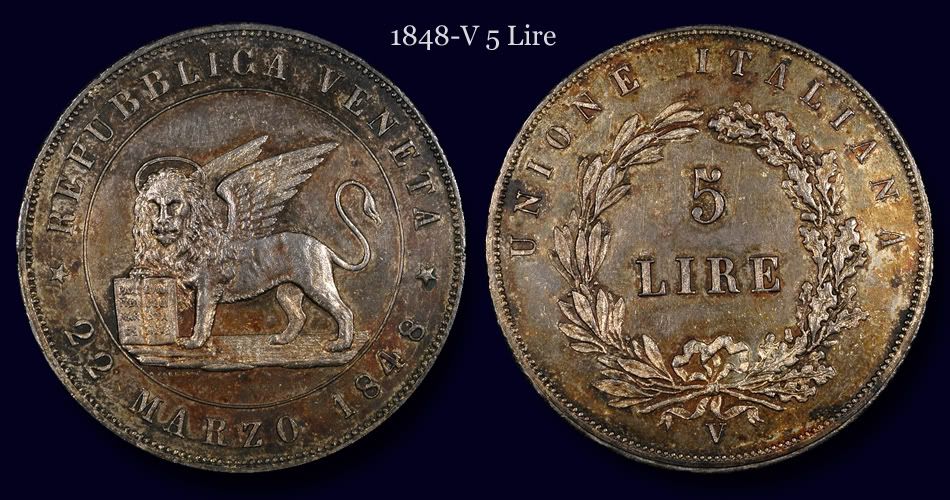
-
This coin (C-186) drips with history. On March 22, 1848, Daniele Manin began an insurrection against the Austrians (Hapsburgs) to whom Napolean had ceded the Veneto region at the end of the 18th century. The Hapsburgs had promised the Venetians self-governance as early as 1815, but they had second thoughts, especially because of the wealth that the region was producing for the empire.
The Venetians (and other provinces of the Veneto region) thought initially that they would receive support both from Piedmont to the northwest (Charles Albert/House of Savoy) and from the Catholic Church and Papal States to the south (Pope Pius IX). Manin was wrong. The Pope would not enter into conflict with the Catholic Hapsburgs, and Charles Albert abandoned support at the risk of losing territory.
The Venetian assembly voted to merge with Piedmont, which was already at war with Austria. Charles Albert pulled out of the deal after a few days to save his own skin, leaving Manin and the provisional government to fend entirely for themselves. Surrender came a year later, in August 1849, after hard fighting and a brutal siege. Still, this rebellion and the others of the same period led to the unification of Italy under the House of Savoy just 12 years later.
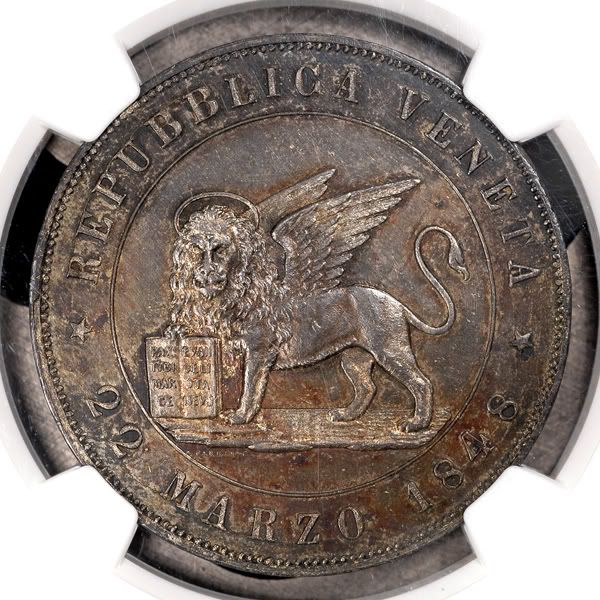
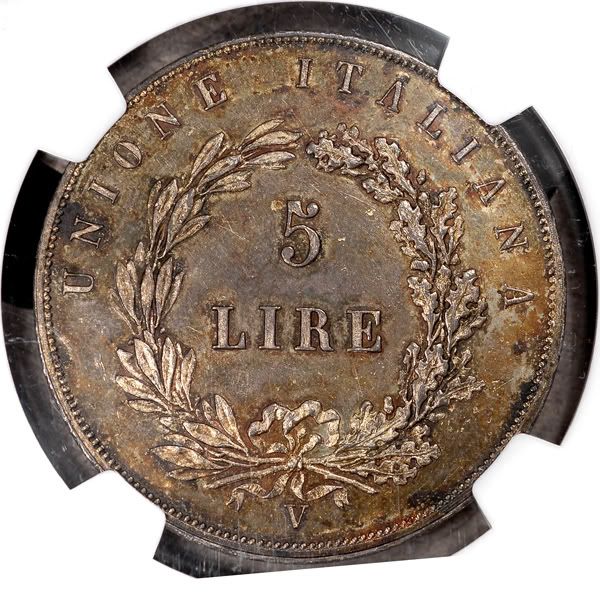
-
-
What's the story on that one, IGWT? It's fantastic!
Taxay refers generally to the 5c patterns of 1867: "When, in 1867, Longacre removed the rays from among the stars, many persons thought that one or the other of the two varieties was counterfeit. Rumors grew so persistent that the Mint considered abandoning the shield and starry circle altogether, and a number of new models were prepared." D. Taxay, The U.S. Mint and Coinage at 245 (1966 & 1983 ARCO Pub. Ed.). Taxay does not provide any citation to the record. Roger Burdette, however, just recently found a letter from Linderman to McCulloch dated June 19, 1867, that fully supports Taxay's statement, and it clearly refers to the design of J-A1867-15 (which is the hub trial for J-566).
Just one week earlier, on June 12, 1867, Longacre had written his own letter to Secretary McCulloch advocating for the adoption of J-561 (struck in aluminum) for regular coinage. The formality of the times and the chain of command required Longacre to send his letter to McCulloch through Linderman. Given the thoughts that Linderman expressed in the June 19 letter, I wonder whether he even bothered to forward Longacre's June 12 letter to McCulloch. In any event, both preceded the uniform minor coinage proposal of 1868; and, although neither design was adopted, both are very important parts to the story of the 5c piece in the history of our federal coinage.
J-A1867-9 is to J-561 what J-A1867-15 is to J-566. Both hub trials go together and should stay together; so, I'm thrilled to place them side-by-side as they likely appeared on Longacre's workbench.

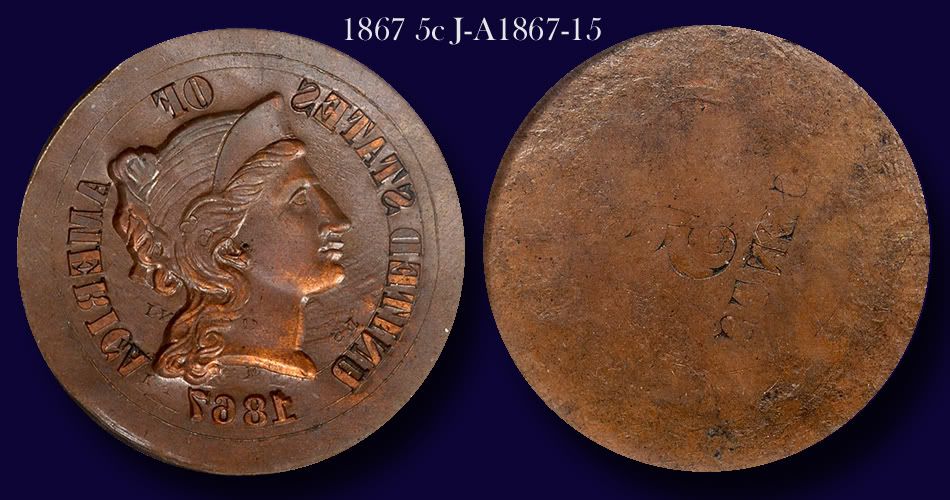
-
-
But you did learn why John Albanese left 1 of the TPG`s?
I've read the book -- and just reread every page where John Albanese is mentioned -- and there is nothing libelous, salacious, or even the least bit controversial. In fact, Travers is nothing but complimentary toward John Albanese. As for the report of why he left PCGS, this is all that Travers writes:
Soon after PCGS began operations in Newport Beach in February 1986, one of its organizers, highly respected coin dealer John Albanese, withdrew and began drafting plans for a new grading service of his own. Albanese felt that PCGS had an Achilles' heel: the possible conflict posted by the fact that its principals were dealing in coins. He set out to form a service that would offer the best of both worlds -- the professionalism of PCGS and the independence of ANACS. In the process, he stopped buying and selling coins himself.S. Travers, How to Make Money in Coins Right Now, 51 (2d ed. 2001).
Oooooooooooooooooooo! Sue me.

-
It's impossible for the market as a whole to undervalue any coin(s).
-
I think "toot your own horn" is the metaphor you intended.
-
Taking the risk of following IGWT's fabulous nickels, here's the latest addition to my type set
Hubba hubba!
-
That's a good read . . . thanks for posting it. I posted this message one year ago, almost to the day:
This consortium conept is a marketing ploy.I wouldn't call it a ploy; although, if I were to be cynical, this is what I'd say:
I've read complaints by top-of-the line collectors and dealers that misgraded and doctored coins are hurting the market. The low-end, overgraded, or problem coins in 65 plastic (as an example) hold down the value of true gems that are also in 65 plastic. All the crackouts and processed coins -- the results of greed in practice -- have reached the point where they actually diminish the value of important segments of the market. Greed has become self-defeating in the current system.
The irony is that greed provides the solution to the problem that it created. Any cure for the current problems must be consistent with the economic self-interest of those who participate in the market. Otherwise, it simply wouldn't work. Those who are involved in the consortium want and need the market to flourish. They have found a way (or, so it seems) to enhance the market in a way that jibes with what many of us want. The consortium expects that the value of the "good" coins will carry the market higher when cut loose from the "bad." They'll benefit as a result, and we'll be satisfied if the program incidentally preserves coins by decreasing the incentive to crack, strip, and dip for an upgrade.
Anyway, that's what I would say if I were a cynic. I don't expect that much will change for me given what I collect.
Link. I'm feeling pretty smart.
 I'm a little surprised, however, to read John Albanese's comment that the problem of doctored coins is "overblown."
I'm a little surprised, however, to read John Albanese's comment that the problem of doctored coins is "overblown." -
A nice mechanical scale with 0.01g accuracy and specific gravity capability. Link to Ohaus 310-00 scale.
-
-
5499 . . . .
-
I know you know your biscuits but is this a bit of a misplaced 1 in the ball ?
I'm tempted to say "yes" just to make you doubly envious.
 But, while it might be the flag or base of a misplaced 1, it's far from conclusive. Which means, for all practical purposes, that it's not. Good eyes, though!
But, while it might be the flag or base of a misplaced 1, it's far from conclusive. Which means, for all practical purposes, that it's not. Good eyes, though! -
Nice coins, everyone! I haven't found much to buy recently, but came across this coin at the show sponsored by the Gorham Coin Club (my local club) last weekend. The Mint hand engraved the outer leaf on the second, right laurel cluster of almost all working dies pressed from Obverse Hub A, but a few slipped through, giving us the missing leaf varieties. There are missing leaf varieties for each year that Obverse A was used, 1866 through the beginning of 1869. This coin is the first missing-leaf variety from 1869 that I've found in mint state condition.
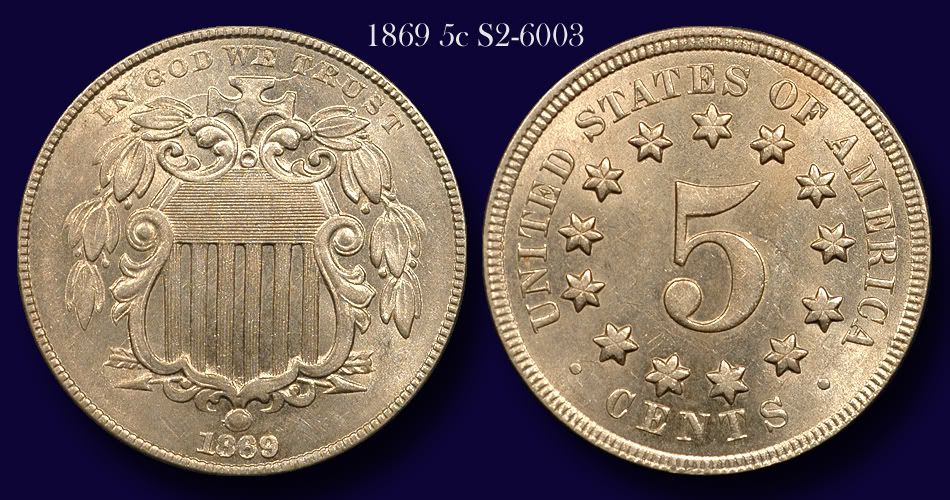
-
Bobby -- You got the 5000th post!

-
I really like visiting this thread, and FUN finally gave me an opportunity to contribute something after a long drought:

-
-







Post your most recent acquisition: US
in US, World, and Ancient Coins
Posted
I opened this thread tonight and suddenly realized that I made the OP four years ago (well, plus a couple months). My, how time flies. I always enjoy visiting to see what others have recently added to their collections, and and I learn a lot by viewing the coins (and comments) posted here. To mark the passage of time, I thought I'd repost pictures of the first coin in the thread followed by more recent -- though still pretty old now -- pictures of the same coin. The good news is that I still like it!